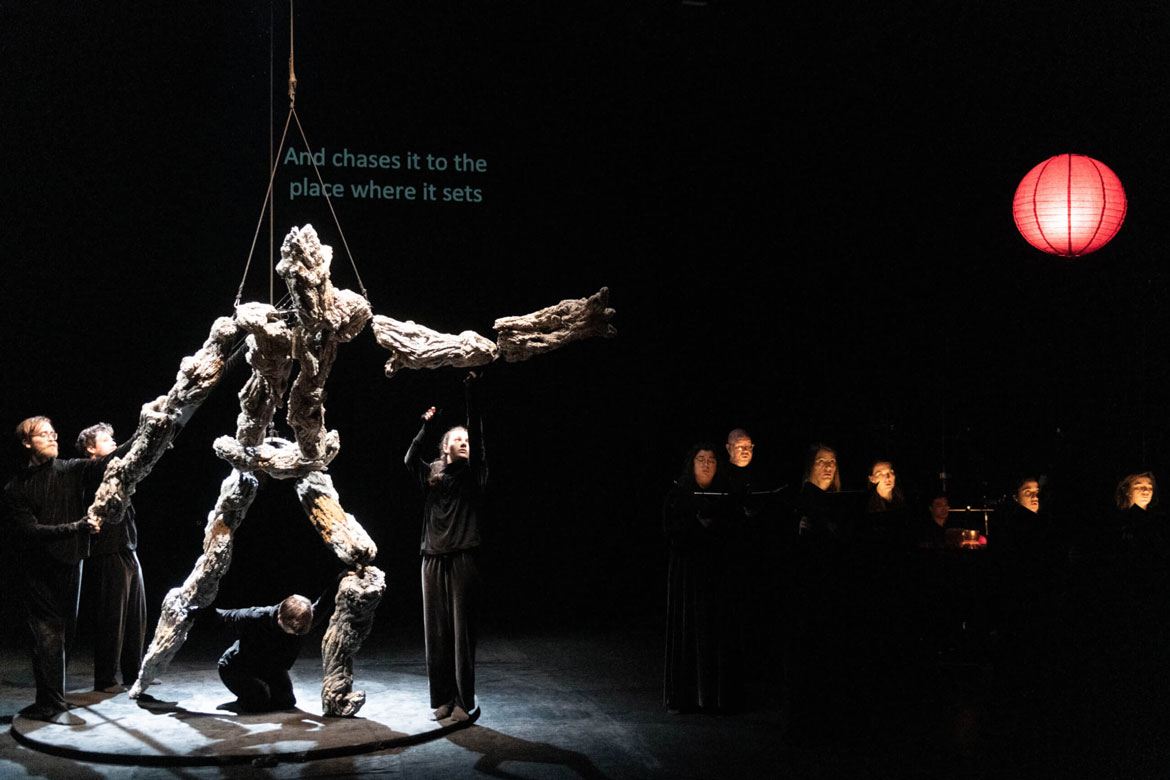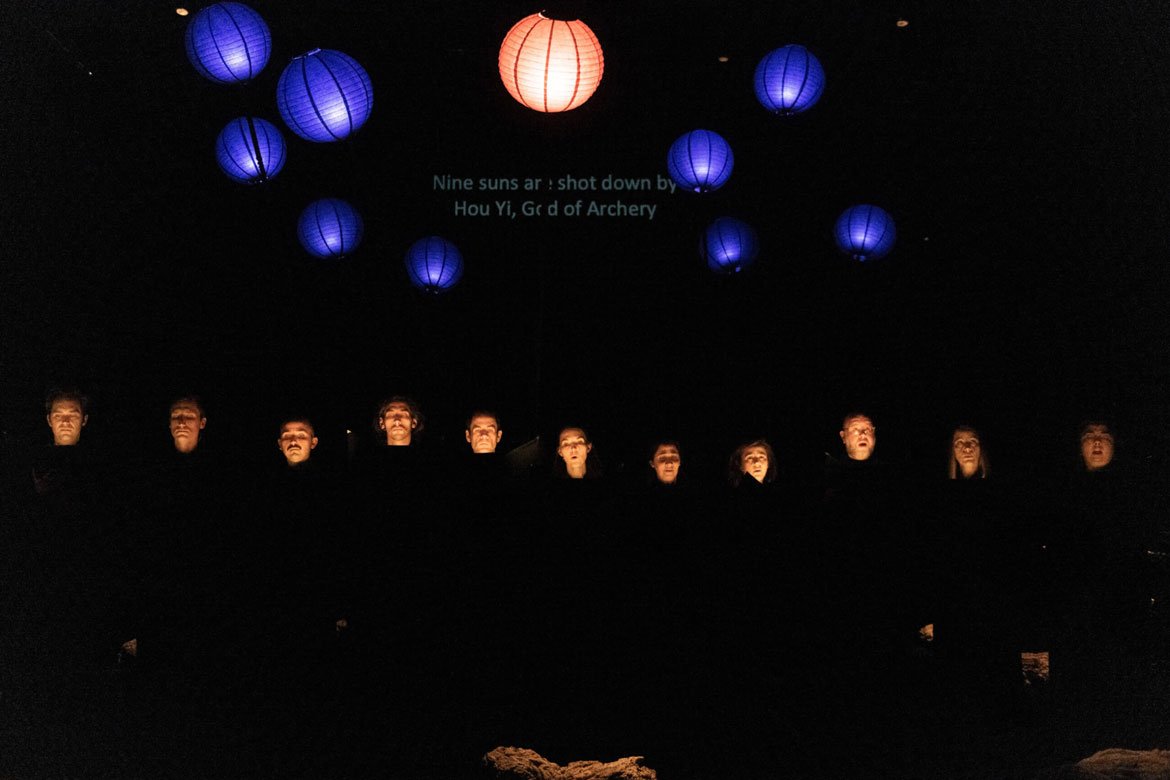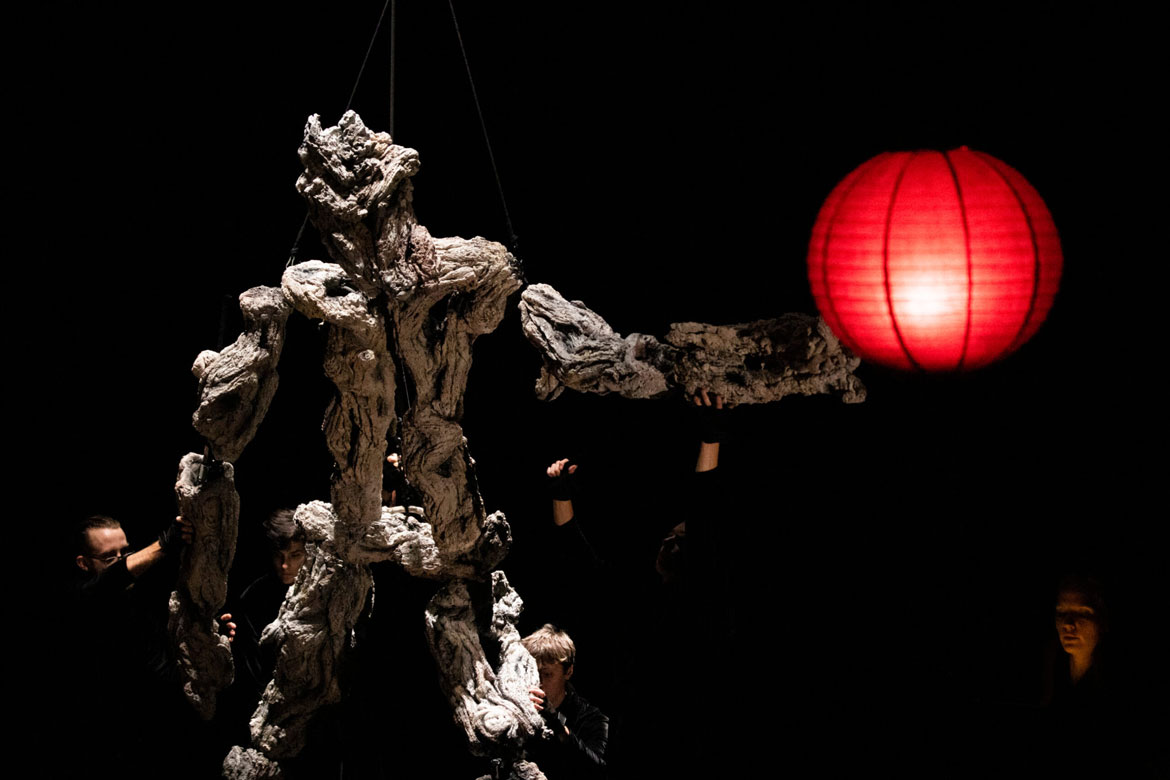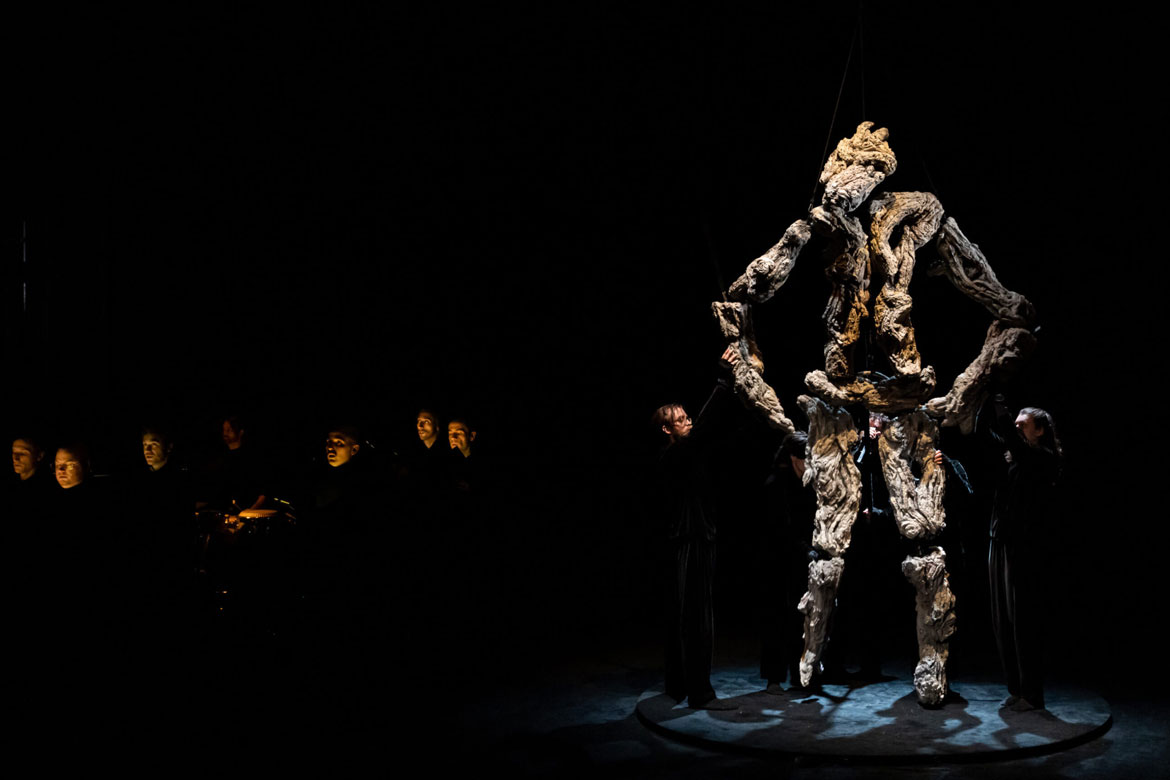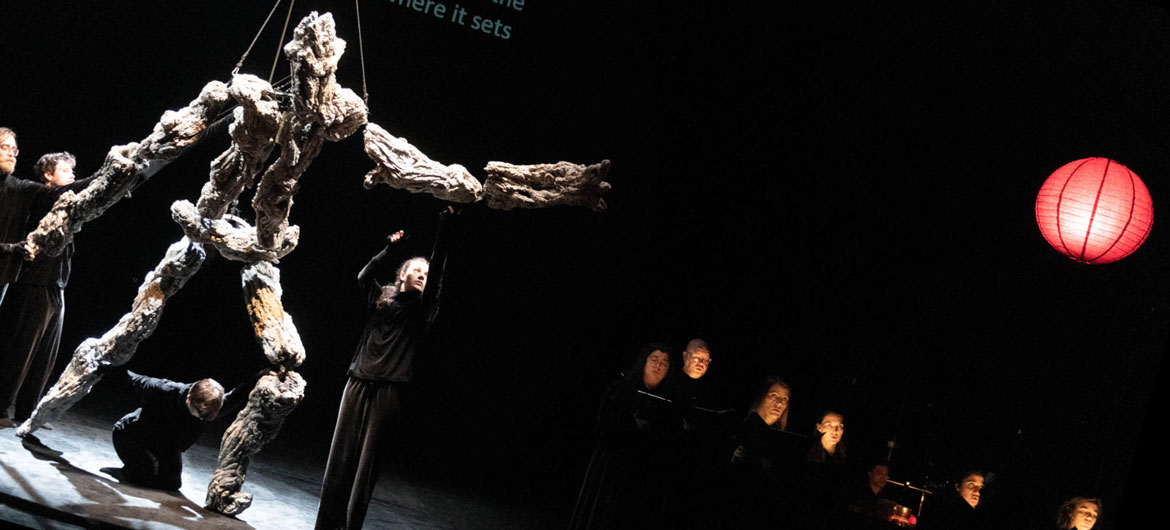“Shanhai jing”—which gives the title to the choral singing and puppetry performance “Book of Mountains and Seas” at ArtEmerson’s Emerson Paramount Center in Boston from April 19 to 21, 2024—is a compendium of Chinese creation myths that was first transcribed in the 4th century B.C.
“It was a book that existed for 2,500 years and we don’t know who wrote it,” Huang Ruo, the show’s Chinese-raised, American-based composer and librettist, explained during a discussion after last night’s performance. “It compiles the geographies of China. Also it collects mythology, stories, folktales of different places. It’s also associated with animals and legends and how the earth was created and why we have one sun left.”
In the show, which premiered in Denmark in fall 2021, Huang’s music is married with director and production designer Basil Twist’s puppetry and live singing by the chorus Ars Nova Copenhagen, all of it produced by Beth Morrison Projects.

The stage is dark for the first scene: “The Legend of Pan Gu.” “Formed in chaos, Pan Gu is the origin” read words projected on a giant dark circle filling the back wall of the stage. “Pan Gu grows taller and taller, between yin and yang, separating heaven and earth.”
The 12 singers slowly appear on the stage as disembodied heads, lit by iPads hidden in the folders they carry, their bodies disappearing in the darkness in their velvety dark robes. The chorus sings a pulsing drone, inspired by Chinese folk music, and recalling medieval European polyphony as well as Philip Glass’s minimalist choral compositions. They’re accompanied by two percussionists. “I wanted to go to the most primitive instrument of mankind. It is voice and percussion,” Huang said. “…To me that is the universal sound.”
The chorus moves to the front, then divides into groups at the sides, revealing a giant face seemingly assembled from thick roots or driftwood with green glowing eyes. “In death he transformed,” read words projected on the back of the stage. “His breath becomes the winds, his blood the rivers, his veins the mountains and canyons, his eyes the sun and the moon. Lastly the humans are created.” (The words can be difficult to read, projected too briefly and frequently blocked by props.)
“The texts are from the book, but they are very short. I also added new texts to it,” Huang said. So addition to singing in Chinese, the vocals include language the composer invented, “what I called a celestial language. … A lot of them are not existing words.”
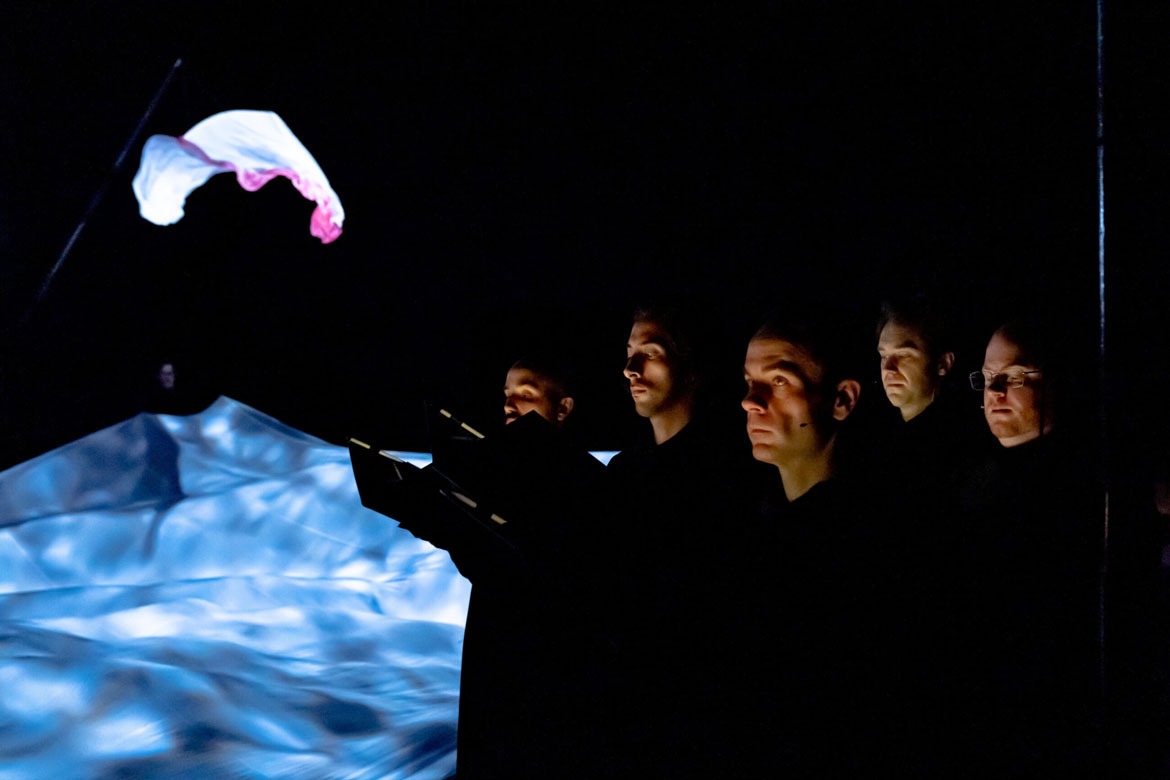
In a second scene, “The Spirit Bird,” a large white sheet is pulled across the stage and rippled like water. Over the sheet, a puppeteer flies a white flag-kite with a pink trailing edge from a long pole—an abstracted bird. It’s initially a striking tableau—but with Twist’s minimalist abstracting puppetry, the performance becomes a dance, and unfortunately Twist’s vocabulary of moves is very limited, which makes the show drag. The puppeteer wags the kite-flag above the rippling sea-sheet with the same simplistic movement over and over and over monotonously. “Nu Wa drowned at sea and was transformed into the bird,” projected words explain. “For the rest of time she fills the sea with twigs and pebbles endlessly.”
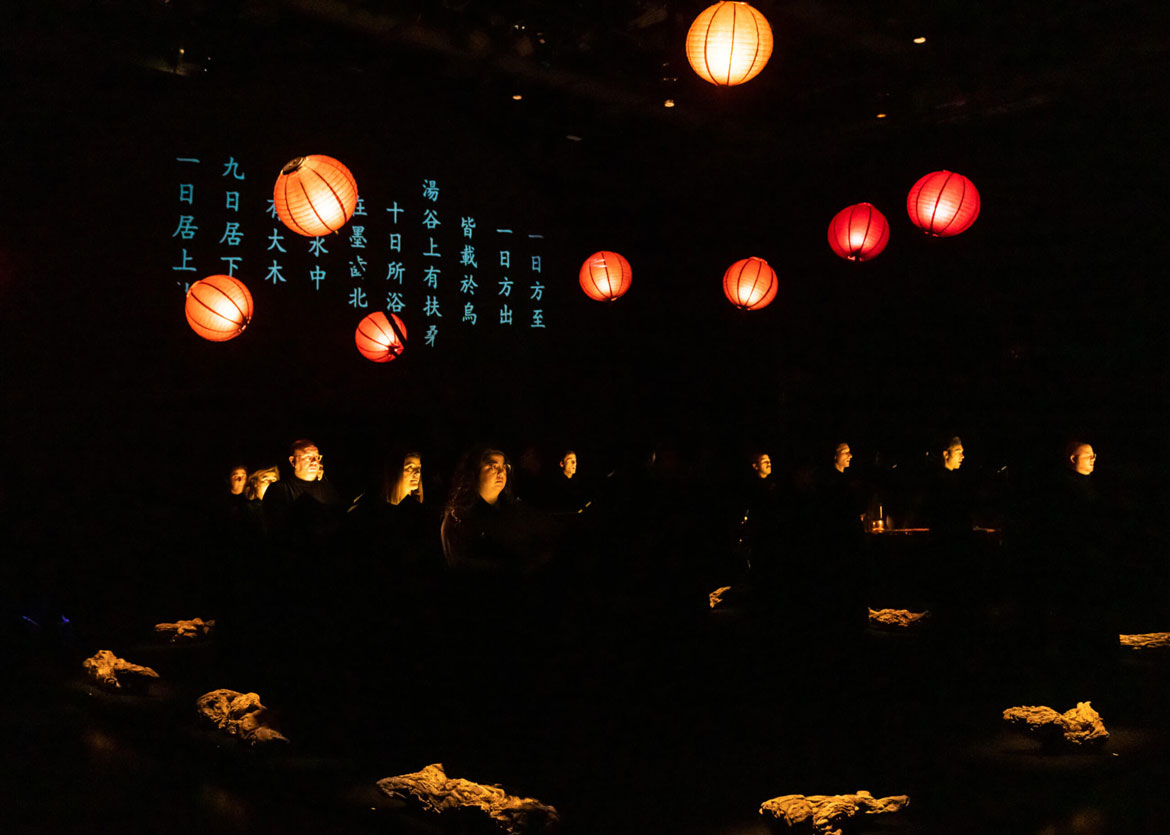
Projected words announce the third scene: “The Legend of 10 Suns”: “Ten suns ride around the Earth on sun birds.” One by one 10 round lanterns, glowing red and held up on tall sticks, are carried in by puppeteers, who walk in slow circles at center stage as the chorus stands at the sides. “One day, the 10 suns decide to all ride together,” projected words explain. “The heat causes grasses and trees to burn, lakes and rivers to dry up, animals and humans to die.” The movement vocabulary remains tediously limited, the lanterns just circling or waving left and right. The puppeteers gather the lanterns in a row at the front of the stage and lean them over the audience ominously. A performer picks up one of the driftwood pieces, which have been arranged around the edges of the stage, as if it is a bow and pantomimes shooting the lanterns, which turn from yellow to blue. “Nine suns are shot down by … the God of Archery.” The lanterns circle and circle, until they finally, one by one, exit at the back. “One sun is spared to light the Earth creating day and night.”

In the final scene, “Kua Fu Chasing the Sun,” the driftwood has been arranged into the shape of a giant monstrous man, who sits up, operated bunraku-style by five and then six puppeteers. The figure runs in place, and runs in place, and runs in place, chasing a red lantern that is carried around the edge of the stage. He falls to his knees to drink white sheet rivers “to quench his thirst,” then runs, then drinks another stream. Then an arm “flies” off toward the sun, then a leg, and another leg, and so on, until all that is left of him is three driftwood logs that puppeteers circle at the center of the stage. “With his death forests of peach blossom trees sprout and grow,” projected words read. The chorus sings in a cluster at the center of the stage as lights come up and pink petals drift down from the ceiling.
“Before he reached the big lake, he actually died from thirst,” Huang said. “In Chinese culture, a peach blossom forest is paradise.” So what are the ancients saying with this tale? “They’re telling us something about how paradise will come about maybe after we are all gone.”
If this is the kind of coverage of arts, cultures and activisms you appreciate, please support Wonderland by contributing to Wonderland on Patreon. And sign up for our free, occasional newsletter so that you don’t miss any of our reporting. (All content ©Greg Cook 2024 or the respective creators.)
